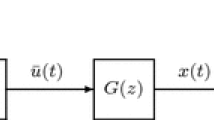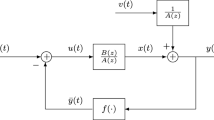Abstract
This paper considers the parameter identification for a special class of nonlinear systems, i.e., bilinear-in-parameter systems. Based on the hierarchical identification principle, a hierarchical stochastic gradient (HSG) estimation algorithm is presented. The basic idea is to decompose a bilinear-in-parameter system into two subsystems and to derive the HSG identification algorithm for estimating the system parameters by replacing the unknown variables in the information vectors with their estimates obtained at the previous time. The convergence analysis of the proposed algorithm indicates that the parameter estimation errors converge to zero under persistent excitation conditions. The simulation results show that the proposed algorithm is effective.

Similar content being viewed by others
References
R. Abrahamssona, S.M. Kay, P. Stoica, Estimation of the parameters of a bilinear model with applications to submarine detection and system identification. Digit. Signal Process. 17(4), 756–773 (2007)
A. Atitallah, S. Bedoui, K. Abderrahim, Identification of wiener time delay systems based on hierarchical gradient approach. in The 8th Vienna International Conference on Mathematical Modelling—MATHMOD, IFAC-Papers OnLine 48(1), 403–408 (2015)
E.W. Bai, An optimal two-stage identification algorithm for Hammerstein–Wiener nonlinear systems. Automatica 34(3), 333–338 (1998)
E.W. Bai, A blind approach to the Hammerstein–Wiener model identification. Automatica 38(6), 967–979 (2002)
E.W. Bai, Y. Liu, Least squares solutions of bilinear equations. Syst. Control Lett. 55(6), 466–472 (2006)
X. Cao, D.Q. Zhu, S.X. Yang, Multi-AUV target search based on bioinspired neurodynamics model in 3-D underwater environments. IEEE Trans. Neural Netw. Learn. Syst. (2016). doi:10.1109/TNNLS.2015.2482501
Z.Z. Chu, D.Q. Zhu, S.X. Yang, Observer-based adaptive neural network trajectory tracking control for remotely operated Vehicle. IEEE Trans. Neural Netw. Learn. Syst. (2016). doi:10.1109/TNNLS
F. Ding, G.J. Liu, X.P. Liu, Parameter estimation with scarce measurements. Automatica 47(8), 1646–1655 (2011)
F. Ding, X.M. Liu, M.M. Liu, The recursive least squares identification algorithm for a class of Wiener nonlinear systems. J. Franklin Inst. 353(7), 1518–1526 (2016)
F. Ding, X.M. Liu, X.Y. Ma, Kalman state filtering based least squares iterative parameter estimation for observer canonical state space systems using decomposition. J. Comput. Appl. Math. 301, 135–143 (2016)
F. Ding, X.H. Wang, Q.J. Chen, Y.S. Xiao, Recursive least squares parameter estimation for a class of output nonlinear systems based on the model decomposition. Circuits Syst. Signal Process. (2016). doi:10.1007/s00034-015-0190-6
F. Ding, X.M. Liu, Y. Gu, An auxiliary model based least squares algorithm for a dual-rate state space system with time-delay using the data filtering. J. Franklin Inst. 353(2), 398–408 (2016)
F. Ding, Y. Gu, Performance analysis of the auxiliary model-based stochastic gradient parameter estimation algorithm for state-space systems with one-step state delay. Circuits Syst. Signal Process. 32(2), 585–599 (2013)
M. Gilson, P. Van den Hof, Instrumental variable methods for closed-loop system identification. Automatica 41(2), 241–249 (2005)
G.C. Goodwin, K.S. Sin, Adaptive Filtering Prediction and Control (Prentice-Hall, Englewood Cliffs, 1984)
A. Haryanto, K.S. Hong, Maximum likelihood identification of Wiener–Hammerstein models. Mech. Syst. Signal Process. 41(1–2), 54–70 (2013)
Y. Ji, X.M. Liu, F. Ding, New criteria for the robust impulsive synchronization of uncertain chaotic delayed nonlinear systems. Nonlinear Dyn. 79(1), 1–9 (2015)
Y. Ji, X.M. Liu, Unified synchronization criteria for hybrid switching-impulsive dynamical networks. Circuits Syst. Signal Process. 34(5), 1499–1517 (2015)
H. Li, Y. Shi, W. Yan, On neighbor information utilization in distributed receding horizon control for consensus-seeking. IEEE Trans. Cybern. (2016). doi:10.1109/TCYB.2015.2459719
H. Li, Y. Shi, W. Yan, Distributed receding horizon control of constrained nonlinear vehicle formations with guaranteed \(\gamma \)-gain stability. Automatica 68, 148–154 (2016)
H. Li, Y. Shi, Robust H-infinity filtering for nonlinear stochastic systems with uncertainties and random delays modeled by Markov chains. Automatica 48(1), 159–166 (2012)
L. Ljung, System Identification: Theory for the User, 2nd edn. (Prentice Hall, Englewood Cliffs, 1999)
J. Pan, X.H. Yang, H.F. Cai, B.X. Mu, Image noise smoothing using a modified Kalman filter. Neurocomputing 173, 1625–1629 (2016)
J.D. Wang, Q.H. Zhang, L. Ljung, Revisiting Hammerstein system identification through the two-stage algorithm for bilinear parameter estimation. Automatica 45(11), 2627–2633 (2009)
D.Q. Wang, Hierarchical parameter estimation for a class of MIMO Hammerstein systems based on the reframed models. Appl. Math. Lett. 57, 13–19 (2016)
X.H. Wang, F. Ding, F.E. Alsaadi, T. Hayat, Convergence analysis of the hierarchical least squares algorithm for bilinear-in-parameter systems. Circuits Syst. Signal Process. (2016). doi:10.1007/s00034-016-0278-7
T.Z. Wang, J. Qi, H. Xu et al., Fault diagnosis method based on FFT–RPCA–SVM for cascaded-multilevel inverter. ISA Trans. 60, 156–163 (2016)
T.Z. Wang, H. Wu, M.Q. Ni et al., An adaptive confidence limit for periodic non-steady conditions fault detection. Mech. Syst. Signal Process. 72–73, 328–345 (2016)
X.H. Wang, F. Ding, Recursive parameter and state estimation for an input nonlinear state space system using the hierarchical identification principle. Signal Process. 117, 208–218 (2015)
D.Q. Wang, F. Ding, Parameter estimation algorithms for multivariable Hammerstein CARMA systems. Inf. Sci. 355, 237–248 (2016)
Y.J. Wang, F. Ding, Recursive least squares algorithm and gradient algorithm for Hammerstein–Wiener systems using the data filtering. Nonlinear Dyn. 84(2), 1045–1053 (2016)
Y.J. Wang, F. Ding, Novel data filtering based parameter identification for multiple-input multiple-output systems using the auxiliary model. Automatica 71, 308–313 (2016)
Y.J. Wang, F. Ding, The filtering based iterative identification for multivariable systems. IET Control Theory Appl. 10(8), 894–902 (2016)
Y.J. Wang, F. Ding, The auxiliary model based hierarchical gradient algorithms and convergence analysis using the filtering technique. Signal Process. 128, 212–221 (2016)
X.H. Wang, F. Ding, Modelling and multi-innovation parameter identification for Hammerstein nonlinear state space systems using the filtering technique. Math. Comput. Modell. Dyn. Syst. 22(2), 113–140 (2016)
C. Wang, T. Tang, Recursive least squares estimation algorithm applied to a class of linear-in-parameters output error moving average systems. Appl. Math. Lett. 29, 36–41 (2014)
C. Wang, T. Tang, Several gradient-based iterative estimation algorithms for a class of nonlinear systems using the filtering technique. Nonlinear Dyn. 77(3), 769–780 (2014)
D.Q. Wang, W. Zhang, Improved least squares identification algorithm for multivariable Hammerstein systems. J. Franklin Inst. 352(11), 5292–5370 (2015)
C. Wang, L. Zhu, Parameter identification of a class of nonlinear systems based on the multi-innovation identification theory. J. Franklin Inst. 352(10), 4624–4637 (2015)
A. Wills, T.B. Schön, L. Ljung et al., Identification of Hammerstein–Wiener models. Automatica 49(1), 70–81 (2013)
W.L. Xiong, J.X. Ma, R.F. Ding, An iterative numerical algorithm for modeling a class of Wiener nonlinear systems. Appl. Math. Lett. 26(4), 487–493 (2013)
X.P. Xu, F. Wang, G.J. Liu, Identification of Hammerstein systems using key-term separation principle, auxiliary model and improved particle swarm optimisation algorithm. IET Signal Process. 7(8), 766–773 (2013)
L. Xu, A proportional differential control method for a time-delay system using the Taylor expansion approximation. Appl. Math. Comput. 236, 391–399 (2014)
L. Xu, Application of the Newton iteration algorithm to the parameter estimation for dynamical systems. J. Comput. Appl. Math. 288, 33–43 (2015)
L. Xu, L. Chen, W.L. Xiong, Parameter estimation and controller design for dynamic systems from the step responses based on the Newton iteration. Nonlinear Dyn. 79(3), 2155–2163 (2015)
L. Xu, The damping iterative parameter identification method for dynamical systems based on the sine signal measurement. Signal Process. 120, 660–667 (2016)
Acknowledgments
This work was supported by the National Natural Science Foundation of China (Nos. 61164015, 60474039) and the Key Research Project of Henan Higher Education Institutions (No. 16A120010).
Author information
Authors and Affiliations
Corresponding author
Rights and permissions
About this article
Cite this article
Ding, F., Wang, X. Hierarchical Stochastic Gradient Algorithm and its Performance Analysis for a Class of Bilinear-in-Parameter Systems. Circuits Syst Signal Process 36, 1393–1405 (2017). https://doi.org/10.1007/s00034-016-0367-7
Received:
Revised:
Accepted:
Published:
Issue Date:
DOI: https://doi.org/10.1007/s00034-016-0367-7




